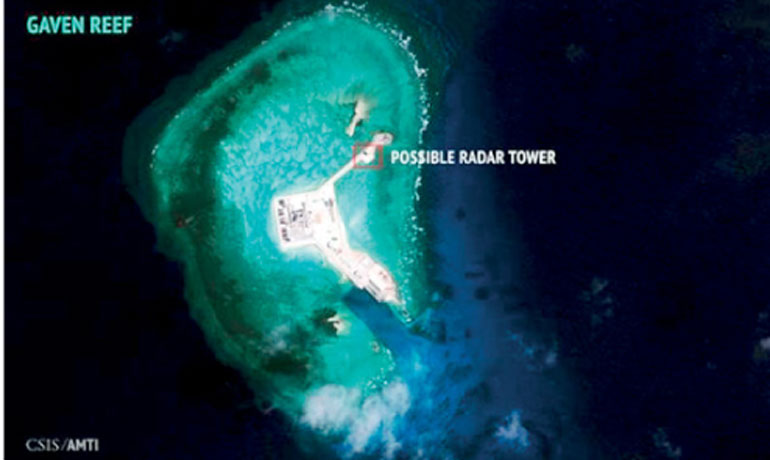Thursday Feb 13, 2025
Thursday Feb 13, 2025
Thursday, 25 February 2016 00:01 - - {{hitsCtrl.values.hits}}
Reuters: China on Wednesday complained the media were ignoring radars and weapons deployed by other claimants in the South China Sea, and unfairly targeting China, following reports of its deployment of fighter jets and radars in the disputed waterway.
Over the past week or so China has been reported to have deployed advanced missiles, fighters and radar equipment on islands in the South China Sea, especially on Woody Island in the Paracels.
Chinese Foreign Ministry spokeswoman Hua Chunying reiterated that as far as China was concerned, there was no dispute over ownership of the Paracels, and so China could deploy what it wanted on its territory without reproach.
“I suggest to the media that, in your reports, you not selectively pump up or ignore things,” Hua told a daily news briefing on Wednesday.
 A satellite image released by the Asian Maritime Transparency Initiative at Washington's Center for Strategic and International Studies shows construction of possible radar tower facilities in the Spratly Islands in the disputed South China Sea in this image released on - Reuters
A satellite image released by the Asian Maritime Transparency Initiative at Washington's Center for Strategic and International Studies shows construction of possible radar tower facilities in the Spratly Islands in the disputed South China Sea in this image released on - Reuters
“Because when you pay attention to what China is deploying, do you also pay attention to other countries which have over the years, on Chinese islands they have occupied, deployed many radars and advanced weaponry? I hope friends in the media can objectively, justly, rationally and calmly make their reports.”
China claims most of the South China Sea, through which more than $5 trillion in global trade passes every year. Vietnam, Malaysia, Brunei, the Philippines and Taiwan have rival claims.
The comments, which come as Chinese Foreign Minister Wang Yi visits the United States, follow remarks on Tuesday by Admiral Harry Harris, head of the U.S. Pacific Command, that China was “clearly militarising” the South China Sea.
Harris said he believed China’s deployment of surface-to-air missiles on Woody Island, new radars on Cuarteron Reef in the Spratlys and its building of airstrips were “actions that are changing, in my opinion, the operational landscape in the South China Sea”.
Discover Kapruka, the leading online shopping platform in Sri Lanka, where you can conveniently send Gifts and Flowers to your loved ones for any event including Valentine ’s Day. Explore a wide range of popular Shopping Categories on Kapruka, including Toys, Groceries, Electronics, Birthday Cakes, Fruits, Chocolates, Flower Bouquets, Clothing, Watches, Lingerie, Gift Sets and Jewellery. Also if you’re interested in selling with Kapruka, Partner Central by Kapruka is the best solution to start with. Moreover, through Kapruka Global Shop, you can also enjoy the convenience of purchasing products from renowned platforms like Amazon and eBay and have them delivered to Sri Lanka.
Discover Kapruka, the leading online shopping platform in Sri Lanka, where you can conveniently send Gifts and Flowers to your loved ones for any event including Valentine ’s Day. Explore a wide range of popular Shopping Categories on Kapruka, including Toys, Groceries, Electronics, Birthday Cakes, Fruits, Chocolates, Flower Bouquets, Clothing, Watches, Lingerie, Gift Sets and Jewellery. Also if you’re interested in selling with Kapruka, Partner Central by Kapruka is the best solution to start with. Moreover, through Kapruka Global Shop, you can also enjoy the convenience of purchasing products from renowned platforms like Amazon and eBay and have them delivered to Sri Lanka.